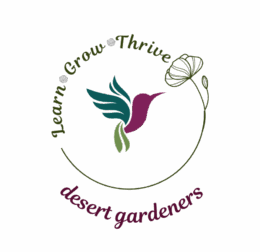Most people with some familiarity with gardening will have read or heard the mantra “Right plant, right place.” But what does that mean, exactly? And how does it apply to desert gardens, particularly those that want to attract native animals?
Broadly speaking, the phrase simply means that gardeners need to consider what plants will thrive in a given spot in their garden (i.e. what is the microclimate and soil like), and then determine whether the plant they choose will actually fit in that spot. For example, if you want to plant something under a large mesquite, you need to consider what plants will do well in its shade. You also need to think about the type and final size of plant you want there. Near walkways, you need to limit yourself to smaller plants, or ones that tend to grow vertically or in small mounds. In patios, you probably want to choose plants with minimal shedding or dropping of leaves, fruit, and the like.
This concept has some major implications for desert gardeners beyond microclimate and size. First, while microclimates are very important, you also need to consider the watering source your new plant will be getting. Even native plants will need irrigation of some type, at least for the first couple of years while they get established. As an example, you don’t want to plant a leafy plant next to your cactus garden because they will need very different watering regimes. This will require you to hand-water the new plant so it gets more moisture, or over-water (and likely kill) the cacti. It’s far better (and less work for you) to have plants with similar water needs in the same areas of your garden.

In addition, you need to pay closer attention than you might think to the aforementioned microclimates. Full sun, part shade, and full shade take on entirely new meanings and restrictions in the desert (see my article on sun and shade for a deeper dive into this topic). Our sun is much stronger due to the lack of water vapor in the atmosphere (which absorbs heat and also refracts the sun’s rays). As an example, if you have a spot in full sun, you need to pick a native plant that thrives in full sun (like creosote bush). A plant that normally grows in riparian areas (which are cooler and shadier) will likely die in a hot sunny spot, even if it’s native.
Second, because many of the native desert plants are thorny, spiny, or in some other way potentially hazardous, you also need to consider the form of the plant along with the size. Yuccas and agaves, along with branching cacti, are frequently planted in inappropriate-sized spaces and next to walkways (like in the photo at the top of the article), ignoring the fact that their poky leaves and thorns will be a hazard for anyone using said walkway. You need to be careful with desert trees and shrubs, too, since many of them have thorns. When a too-large, thorny plant is planted in a small space, it often ends up getting trimmed back to ugliness–like in the photo below.

There are also practical considerations in siting your plants, particularly when planting for wildlife. If you’re planting a pollinator garden but a member of your family has bee sting allergies, you will want those plants in a remote corner of your yard. If you’re planning a wild area, site it away from the house so that you don’t disturb the critters and they don’t disturb you—this particularly applies to native rodents like packrats, piles of debris that will attract insects, and the inevitable predators (like snakes) that will seek out the aforementioned yard dwellers. Many people plant wildlife gardens and then seem to be surprised when the wildlife actually shows up! Don’t have wildlife-attracting areas where said wildlife can get into your house, damage your property, or harm pets or children.
Thus the “right plant, right place” mantra is important for all gardeners, but it’s critical for desert gardeners because the stakes are potentially higher. Following these principles will help you avoid wasting money on inappropriate plants, or on trimming and moving large, unwieldy plants that are incorrectly placed.



